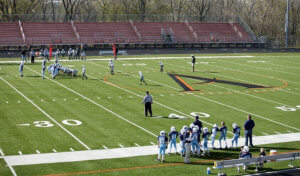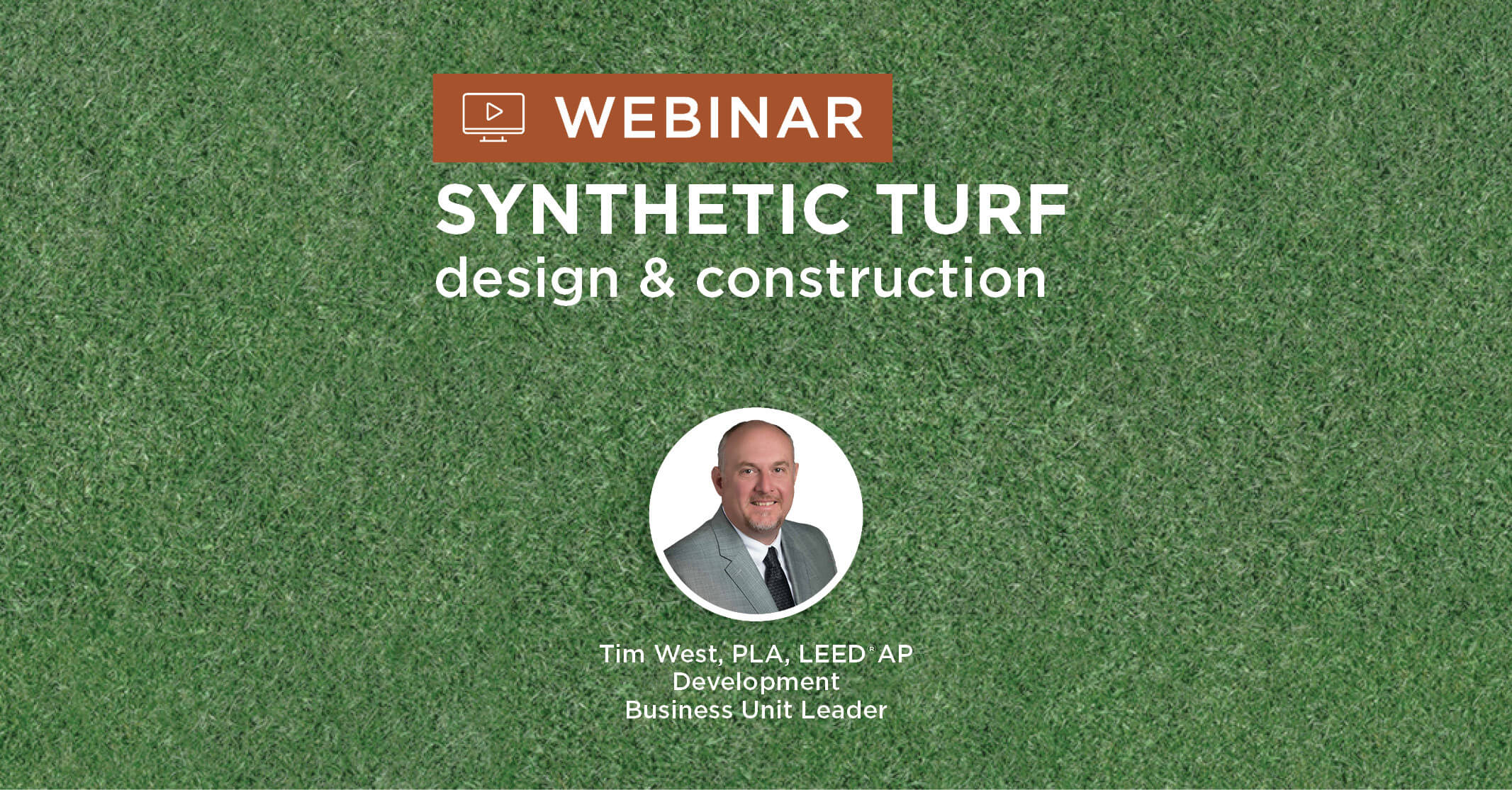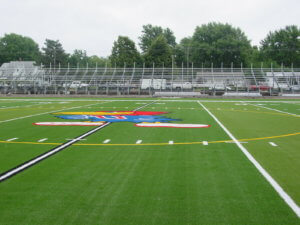Synthetic Turf Artificial Grass Surface For Sports Fields
Synthetic turf design is a popular and versatile solution for sports field surfaces. Its durability allows for increased scheduling of practice and gameplay for multiple activities, including field hockey, marching band, football, baseball, soccer, lacrosse, and rugby.
Landscape Architect Tim West, PLA, hosts this webinar episode on synthetic turf field surfacing. He’ll outline what to consider when planning and maintaining a synthetic turf sports field.
Webinar Agenda
- Synthetic Turf System Cross-Section (1:51)
- Common Synthetic Turf Systems (3:04)
- Synthetic Turf Trends – Blended Fiber System (5:20)
- Synthetic Turf Trends – Alternative Infills (6:03)
- Synthetic Turf Trends – Shock Pads (7:07)
- Sub-Soil and Granular Base (7:56)
- Stormwater Management (8:51)
- Synthetic Turf Design Schedule (9:38)
- Synthetic Turf Construction Schedule (10:20)
- Synthetic Turf Construction Costs (11:41)
Synthetic Turf System Cross-Section (0:18)
The popularity of synthetic turf has really grown in the last 10 to 15 years. Most schools have access to a synthetic turf field if they don’t own one themselves. But a lot of school districts have two synthetic turf fields, or some may even have three in the Metro. We’ve worked with a number of school districts that we’ve started to incorporate baseball into their synthetic turf programming and facilities as well. So it’s really growing. It’s a trend that has a lot of advantages. The largest one is the wear and tear on a synthetic turf field. It’s pretty easy to offset the maintenance. It’s very minimal. You’re just grooming back the infill instead of trying to keep up with growing back new grass and aerating and fertilizing. It allows you to put multiple sports and multiple PE programs onto the field, back to back to back.
The other advantage of synthetic turf is you can get out onto that turf almost directly after a rain event. You theoretically can go ahead and play in the rain or light drizzle if it’s safe enough. But I’ve seen where they’ve run two to three a day practices, back to back, with different sports teams at small colleges. As soon as it stops raining, they run the squads back out and get practicing. So very multipurpose allows for a lot of different activities, and the advantages are pretty substantial. The maintenance is low, too. The trade-off is that they cost quite a bit to put in initially. And we’ll walk through some of those budgets here in a minute.
A typical cross-section for a synthetic turf field looks like this image on the screen. Fiber and infill systems and turf backing are all products that you’re going to pick out from the manufacturer. What we’re focusing on for design are the granular drainage layers. There’s a two-inch layer on the top, which really consists of a quarter to three-eight-inch chip clean crushed stone, that allows positive drainage through that layer coming out of the turf backing, and it moves into a four-inch base gradation, which is typically similar to a one inch clean with the three-eights minus clean chip in it. It’s a little more complicated than that. The gradation is very, very important on both of those two layers so that we have positive drainage that gets directly to the perforated collector pipes that’ll be spaced out throughout the turf system. That granular base is wrapped in geotextile fabric, and with the way that it is all installed, there’s quite a bit of compaction. There’s not a lot of infiltration associated with synthetic turf fields. Most of the water that gets through the turf system gets into the collector pipes and onto the storm sewer system.
Common Synthetic Turf Systems (3:04)
The image on the screen is kind of the run-of-the-mill synthetic turf system. All manufacturers produce a generic turf, which has a punch hole backing, which is similar to the photo on the bottom left. It has a full rubber infill system and your choice of a fiber system, whether it’s monofilament, slit film, or a blend of the two. This is generally the most inexpensive version of synthetic turf, and almost all manufacturers produce something similar to this. So this is a great place to start if you’re new to synthetic turf products. This is your first field. This allows you the broadest amount of bidders and products that can be recognized as altar or as equal products. And it can open you up to additional bidders where some types of proprietary systems will restrict you to certain brands.
An example of that is on the left there. That’s a cross-section through a particular field turf field. You can see that the blend of the infill system is different. That’s proprietary. Some of the unique fiber systems can take many different shapes. Those can be proprietary and protected through copywriting. So if you’re thinking about selecting a particular type of fiber system or turf system, you’ll want to be aware that the more detailed or the more proprietary that you’re selecting for their higher level of products that you get to you’re going to be probably narrowing the number of people that can bid on the project.
Another cross-section is similar to the one on the right, where you separate out the sand as a more balanced layer. A rubber or some sort of infill is placed above that if you have a shorter pile height to offset investment into a shock pad underlayment. So, there’s a growing case for shock pads underneath these turf fields. This would be a cross-section that allows you to save a little bit of money in the shorter pile height, more sand, a little less infill, and then your money is going into a shock pad to create that impact zone.
Synthetic Turf Trends – Blended Fiber System (5:20)
Synthetic turf trends tend to be associated with those three items as well. Fiber infill and shock pads. The photo on the top left is a photo of a blended system. You can kind of see the wider blades of grass within there and the narrower ones. The wider ones are slit film. Those have a tendency to split, and they call it the defibrillate. It allows you to encapsulate the infill a little bit better and keep it from flying out. The monofilament is more upright and a little more durable, and that can provide kind of the best of both worlds—some durability along with a reduction to fly out. Most of the brands offer a blended fiber system. And that’s the way that we’ve been moving with our recommendations.
Synthetic Turf Trends – Alternative Infills (6:03)
When you move into alternative infills, there are a lot of different experimental infills out there. Most of them have been developed to offset heat retainage on fields. And that’s especially important in the South. Some biodegradable or recyclable materials have also come onto the market. The one on the bottom is more of a biodegradable product. There are some core products available. People have really been experimenting with those. The one on the top, the green one, is a Nike Grind, which consists of recycled athletic shoe soles. So there’s a lot of experimenting out there. We’re sticking with the tried and true rubber sand mixes, but we’ve had some clients that want to explore these. And I think the biggest benefit is some of the heat retainage offset. By going with a lighter color, you will be spending more money to approach one of these infills and distribute it all across your field. It really adds up. It’s probably a dollar more a square foot.
Synthetic Turf Trends – Shock Pads (7:07)
Shock pads are starting to come onto the scene. They’re starting to be kind of controversial, too, because there’s a fairly large expense associated with it. A lot of turf manufacturers say that their base rubber infill systems supply the shock or impact resistance at low levels that you would need for safety. There’s also been a few studies that have said most of the impact occurs on a field between player-to-player impacts and not necessarily player-to-ground impacts when you talk about concussions and other injuries. So you’ll want to take a look at that carefully. We can help you with some literature on what the trends are and what the latest information is. There are not a lot of shock pads in the turf pads or the turf systems around the central Iowa area. So it’s kind of an emerging technology that we’re keeping our eye on.
Sub-Soil and Granular Base (7:56)
Again, subsoil and the granular base are important. We want to make sure that we’re looking at the gradation of the rock and allowing for the same treatments that we talked about under the track section. Sub-soils really need to be compacted in 95 percent so that they can hold up the granular base and the synthetic turf system that creates a pretty impermeable layer that starts to build, reducing infiltration.
Here’s a couple of photos of in construction. The top left shows the placement of the sub-base material. The one on the right shows a picture of the installation of the turf curb, a lot of utility work on the bottom left there. You can see there’s quite a bit that happens underneath the field and the one on the right is a finished base rock product ready to go for synthetic turf installation.
Stormwater Management (8:51)
Most jurisdictions require some sort of stormwater management. The easiest way to do this is to route some drains to the stormwater basin outside of the field area. We can store some stormwater in the granular base, but we would want that in an extended horizon on that. So, if we wanted to put an extra foot or so of rock, we could utilize the voids in there to store water. But we have to calculate that fairly specifically and work with the city on how we’re reducing those flow rates out of the base. It is an option if you’re really landlocked and have no extra room. But we have to use a lot of caution on that. But plan on some sort of stormwater management requirement if you’re in a larger jurisdiction or in an area that really has a lot of regulation controlling that.
Synthetic Turf Design Schedule (9:38)
Design schedules follow, similar to what Clay described for the track. We want to make sure that we’re taking advantage of January or February bidding. The main reason for that is because the turf manufacturers start to take on their orders in March and April. We want to be more at the beginning of the line and have some control over when our turf products are going to come out versus being at the end of the line and possibly not receiving our turf until the last second, late in the summer—same 12-week design time. We still want to get geotechnical work going maybe a little bit earlier because we have a little bit more design to do. We want to hit that in January and February, and not necessarily in March or April.
Synthetic Turf Construction Schedule (10:20)
For the construction schedule, there are a couple of dates that we use as a rule of thumb. The granular base needs to be underway by July 4th if we’re going to open that field up for varsity football in the fall, that’s usually a specific date that we have to hit. That gives us the ability to install the turf system. With the new stadium up in Ankney, they were forced to meet a solid date. It was the first year that they were playing an Ankeny vs Ankeny game at Northview stadium, and the turf field had to be done by that date, no matter what. No alternative venue was available. So, they were able to install that turf field in 12 days. It was under the lights. There was quite a bit of hectic work associated with that, but they can do it quicker. we would recommend allowing at least 30 days for that field installation and setting up these dates. If you don’t have a big hurry and you can put that in maybe in the fall, just remember that there are quite a few adhesives associated with the installation of different field markings and joining together the turf rolls that you will have to hit some minimum temperatures. Usually, mid-October is another date that we try to shy away from doing any work after that date for putting these fields together at the end.
Synthetic Turf Construction Costs (11:41)

Not only do turf fields provide a consistent playing surface with improved safety features, but they also save money on maintenance costs while reducing water usage.
Again, some construction photos show finishing up work on the installation of the turf field. The bottom left corner shows the interaction between a track ring, the edge of the track, and the edge of the football field. And you can see that there are quite a lot of different surfaces and systems that interface in those corners. Those are important construction areas that we want to inspect to make sure they get those right.
From a cost standpoint, one area that we’ve seen people underestimate is the excavation for existing topsoil. If you have a natural field that’s been there for years and years, you could have two feet of topsoil in there when you take into account a one-and-a-half percent crown on the field, so you could have upwards of 5,000 cubic yards of soil to haul out. That could be an excess of $50,000 just to haul the soil out. That’s a big amount. It’s hard to hide that someplace on site. We want to make sure we include that in any of the construction budgets and cost estimates. We talked about the soil treatments. We want to make sure we carry an allowance in case we need that for poor weather or have to hit a particular date if we have a tight schedule. A little bit more, in this case, about $100,000 potentially if we had to fly Ash the entire field. We recommend budgeting about 1 million dollars to 1.3 for a full new field system installation. If you already have a field and you’re looking to replace it, we’re using a budget of about 6 to $700,000 for that effort.

Tim West, PLA, LEED®AP
Development Business Unit LeaderTim West, PLA, LEED®AP
Development Business Unit LeaderMaster Planning, Project Management, Athletic Design, Park Design, Public Engagement

